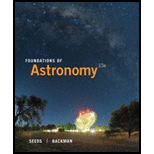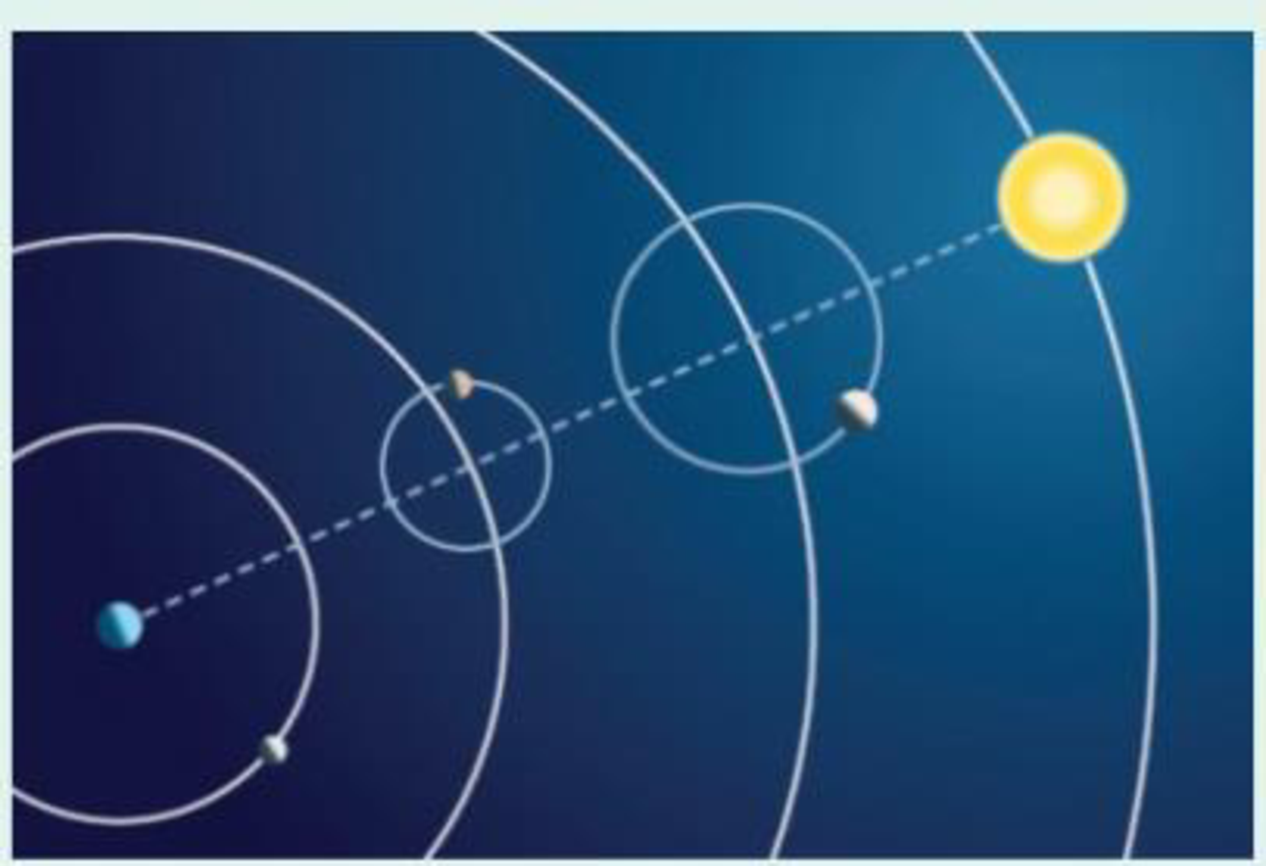
Foundations of Astronomy
13th Edition
ISBN: 9781305079151
Author: Michael A. Seeds, Dana Backman
Publisher: Cengage Learning
expand_more
expand_more
format_list_bulleted
Textbook Question
Chapter 4, Problem 4LTL
Use the figure below to explain how the Ptolemaic model treated some planets differently from the rest. How did the Copernican model treat all of the planets the same?

Expert Solution & Answer
Trending nowThis is a popular solution!

Students have asked these similar questions
Consider a rubber rod that has been rubbed with fur to give the rod a net negative charge, and a glass rod that has been rubbed with silk to give it a net positive charge. After being charged by contact by the fur and silk...?
a. Both rods have less mass
b. the rubber rod has more mass and the glass rod has less mass
c. both rods have more mass
d. the masses of both rods are unchanged
e. the rubber rod has less mass and the glass rod has mroe mass
8) 9)
10)
11)
12)
13)
14)
15)
Chapter 4 Solutions
Foundations of Astronomy
Ch. 4 - Prob. 1RQCh. 4 - Why did early human cultures observe astronomical...Ch. 4 - Prob. 3RQCh. 4 - Name one example each of a famous politician,...Ch. 4 - Why did Plato propose that all heavenly motion was...Ch. 4 - On what did Plato base his knowledge? Was it...Ch. 4 - Which two-dimensional (2D) and three-dimensional...Ch. 4 - Are the spheres of Eudoxus a scientific model? If...Ch. 4 - In Ptolemys model, how do the epicycles of Mercury...Ch. 4 - Prob. 10RQ
Ch. 4 - In Ptolemys model, which of the followingepicycle,...Ch. 4 - Why did Copernicus have to keep small epicycles in...Ch. 4 - Was the belief held by ancient astronomers that...Ch. 4 - When Tycho observed the new star of 1572, he could...Ch. 4 - Prob. 15RQCh. 4 - Does Tychos model of the Universe explain the...Ch. 4 - Name an empirical law. Why is it considered...Ch. 4 - How does Keplers first law of planetary motion...Ch. 4 - When Mercury is at aphelion (farthest from the...Ch. 4 - Prob. 20RQCh. 4 - What is P for Earth? What is a for Earth? Do these...Ch. 4 - Based Figure 4-13c, do planets with larger a take...Ch. 4 - How did the Alfonsine Tables, the Prutenic Tables,...Ch. 4 - Explain how each of Galileos telescopic...Ch. 4 - How did discovery of the Galilean moons disprove...Ch. 4 - Prob. 26RQCh. 4 - How Do We Know? Describe the differences between a...Ch. 4 - Prob. 1DQCh. 4 - Prob. 2DQCh. 4 - Prob. 3DQCh. 4 - Prob. 4DQCh. 4 - Prob. 5DQCh. 4 - Draw and label a diagram of the western horizon...Ch. 4 - If you lived on Mars, which planets would exhibit...Ch. 4 - How long does it take for one retrograde cycle of...Ch. 4 - If a planet has an average distance from the Sun...Ch. 4 - If a space probe is sent into an orbit around the...Ch. 4 - Uranus orbits the Sun with a period of 84.0 years....Ch. 4 - Prob. 7PCh. 4 - One planet is three times farther from the Sun...Ch. 4 - Galileos telescope showed him that Venus has a...Ch. 4 - Which is the phase of Venus when it is closest?...Ch. 4 - Galileos telescopes were not of high quality by...Ch. 4 - Prob. 1LTLCh. 4 - Study Figures 4-11 and 4-16 and describe the...Ch. 4 - What three astronomical objects are represented...Ch. 4 - Use the figure below to explain how the Ptolemaic...
Knowledge Booster
Learn more about
Need a deep-dive on the concept behind this application? Look no further. Learn more about this topic, physics and related others by exploring similar questions and additional content below.Similar questions
- Mick and Rick are twins born on Earth in the year 2175. Rick grows up to be an Earth-bound robotics technician while Mick becomes an intergalactic astronaut. Mick leaves the Earth on his first space mission in the year 2200 and travels, according to his clock, for 10 years at a speed of 0.75c. Unfortunately, at this point in his journey, the structure of his ship undergoes mechanical breakdown and the ship explodes. How old is Rick when his brother dies?arrow_forwardHi, I have canceled, why did you charge me again?arrow_forwardNo chatgpt pls will upvotearrow_forward
arrow_back_ios
SEE MORE QUESTIONS
arrow_forward_ios
Recommended textbooks for you
 Foundations of Astronomy (MindTap Course List)PhysicsISBN:9781337399920Author:Michael A. Seeds, Dana BackmanPublisher:Cengage Learning
Foundations of Astronomy (MindTap Course List)PhysicsISBN:9781337399920Author:Michael A. Seeds, Dana BackmanPublisher:Cengage Learning Stars and Galaxies (MindTap Course List)PhysicsISBN:9781337399944Author:Michael A. SeedsPublisher:Cengage Learning
Stars and Galaxies (MindTap Course List)PhysicsISBN:9781337399944Author:Michael A. SeedsPublisher:Cengage Learning
 AstronomyPhysicsISBN:9781938168284Author:Andrew Fraknoi; David Morrison; Sidney C. WolffPublisher:OpenStax
AstronomyPhysicsISBN:9781938168284Author:Andrew Fraknoi; David Morrison; Sidney C. WolffPublisher:OpenStax
 Stars and GalaxiesPhysicsISBN:9781305120785Author:Michael A. Seeds, Dana BackmanPublisher:Cengage Learning
Stars and GalaxiesPhysicsISBN:9781305120785Author:Michael A. Seeds, Dana BackmanPublisher:Cengage Learning

Foundations of Astronomy (MindTap Course List)
Physics
ISBN:9781337399920
Author:Michael A. Seeds, Dana Backman
Publisher:Cengage Learning

Stars and Galaxies (MindTap Course List)
Physics
ISBN:9781337399944
Author:Michael A. Seeds
Publisher:Cengage Learning


Astronomy
Physics
ISBN:9781938168284
Author:Andrew Fraknoi; David Morrison; Sidney C. Wolff
Publisher:OpenStax


Stars and Galaxies
Physics
ISBN:9781305120785
Author:Michael A. Seeds, Dana Backman
Publisher:Cengage Learning
Kepler's Three Laws Explained; Author: PhysicsHigh;https://www.youtube.com/watch?v=kyR6EO_RMKE;License: Standard YouTube License, CC-BY